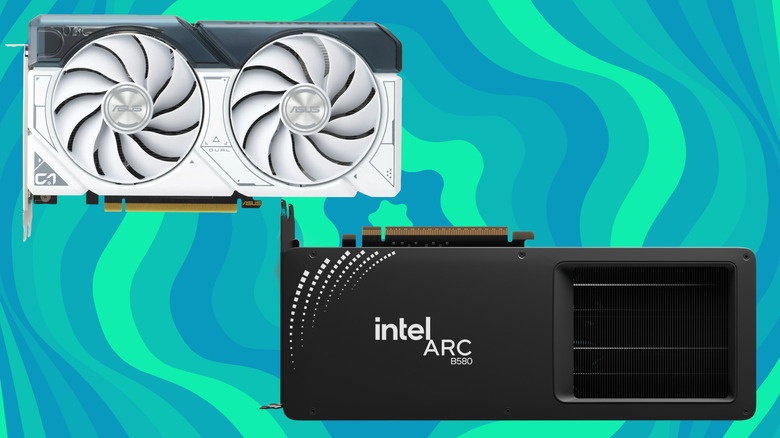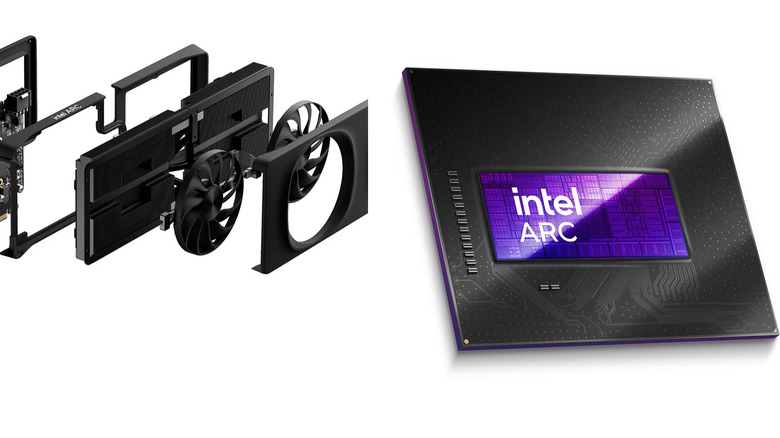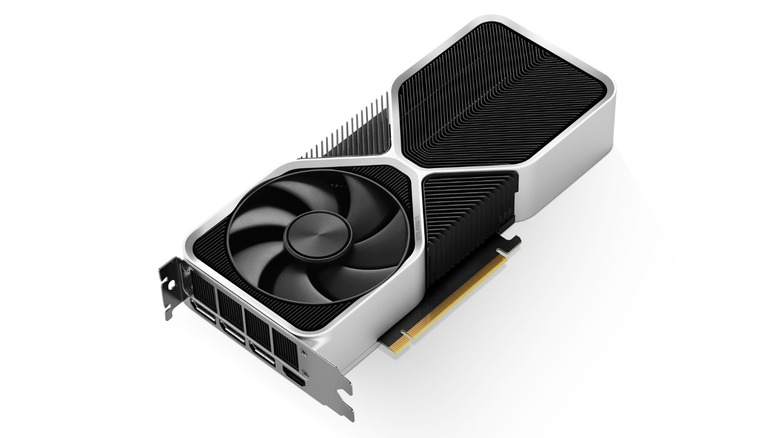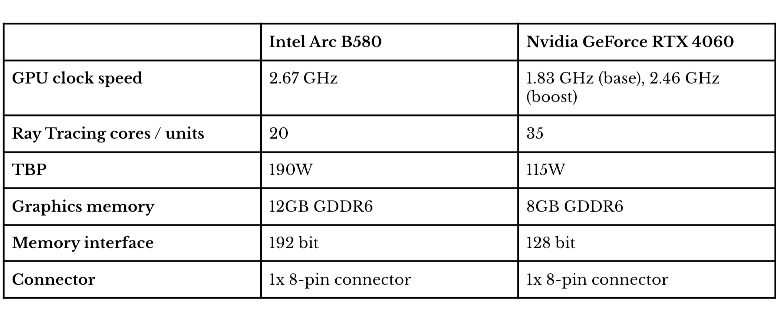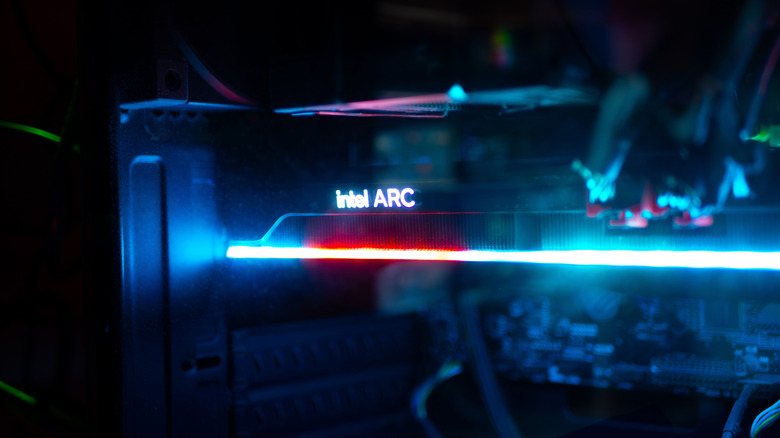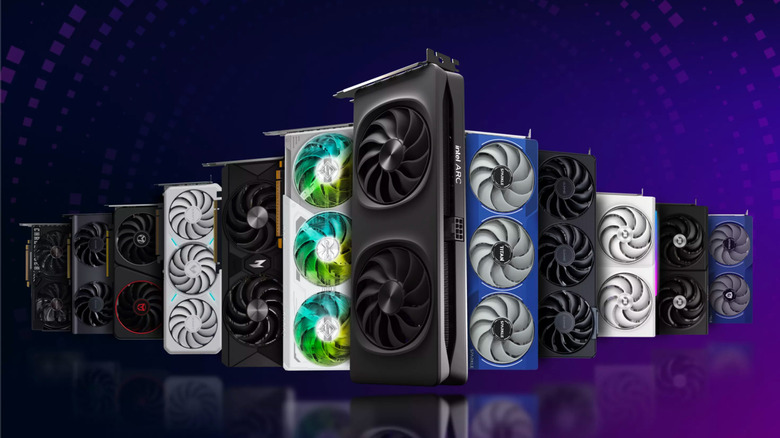Intel Arc B580 Vs. Nvidia RTX 4060: How Do These GPUs Compare?
Intel's foray into the domain of discrete graphics cards with the Arc series was not entirely unexpected, but it certainly was received with a copious dosage of skepticism by PC enthusiasts, especially in light of Nvidia and AMD's dominance in the segment. Could a third player survive? Well, to the surprise of many, Intel notched quite a surprising victory with the Arc B580 GPU, which goes toe-to-toe against the Nvidia GeForce RTX 4060.
Intel launched the Arc B series of graphics cards just a few weeks ago, promising "best-in-class value for performance." The troubled chipmaker — which recently retired veteran CEO Pat Gelsinger and currently stares at an ever-tight silicon competition — made it clear that it is going for the value crown with solutions that are accessible to gaming enthusiasts. The Arc B580 won a lot of praise for its price-to-performance ratio, and if tests by independent experts and tech media are anything to go by, the Intel option has sidelined the AMD competition in this bracket. For example, PCWorld's review labeled it "the first worthy budget GPU of the decade."
Amassing that kind of reception, especially when going for $250 against the RTX 4060's sticker price of $299, undercutting Nvidia's well-received graphics cards is no small feat. And certainly not in the second-gen iteration itself. Praise has also been directed towards the cooling performance, raw ray-tracing output, and better visual experience in a healthy bunch of games.
Core differences between Intel and Nvidia's budget warriors
Intels' graphics card is based on the Battlemage architecture. On paper, the biggest advantage of investing in the Arc B580 over the Nvidia GeForce RTX 4080 is the higher memory capacity as well as bandwidth. On the Arc series offering, you get 12GB of GDDR6 VRAM tied to a 192-bit memory bus, compared to the 8GB of GDDR6 VRAM on the Nvidia rival, which also goes with the tighter 128-bit lane.
That difference translates to more headroom for fetching game assets, especially when you are pushing a machine with higher-resolution figures. Moreover, it is a no-brainer that picking a GPU engine with 50% more memory is the more future-proof investment. If you are planning to stick with your next GPU for at least the next few years and don't want to stick with the "minimum" game performance tier, the Intel GPU is the better solution.
Another key consideration is the total power. The Intel GPU sits at 190W TBP figures, while the Nvidia option ranks much lower at 115W. The gulf is not exactly small, but according to tests conducted by the folks over at RockPaperShotgun, the Intel GPU only went as far as 118W, while the Nvidia GeForce RTX 4060 touched 128W. In addition to the lower power draw, the Arc GPU also ran cooler compared to its Nvidia rival. Another advantage is that the Arc B580 GPU comes with dual codec engines, compared to the single unit on its Nvidia challenger. This is another advantage for content creators and streamers, as the GPU opens the doors for handling two video-related streams simultaneously.
What Intel has to offer against Nvidia?
Intel claims the B580 desktop graphics engine is tailor-made for gaming at 1440p resolution, which is not bad given its asking price. But it's not all about raw hardware grunt, as Intel is also taking the battle to software-based solutions for upscaling and game fluidity. The Arc GPU offers support for the next-gen XeSS-SS Super Sampling tech stack. It opens the doors for XeSS-SR (Super Resolution) tech, nearly doubling the FPS count in certain games.
The XeSS 2 stack also opens the doors for AI-assisted frame generation. The AI-generated frames are interspersed between the native system frames to offer a smoother visual experience. Intel also offers its own take on latency reduction tech, which relies on custom algorithms to tone down the gap between user input in response to the on-screen frame activity.
Where Nvidia scores a crucial victory is the support for DLSS, which is ready for a dramatically higher number of games compared to what Intel has to offer with XeSS compatibility, even though the Intel option doesn't really lag behind in performance at upscaling and frame generation. If you are buying the Intel GPU for AI-related tasks, there is little to feel disappointed here, especially if you are torn between the Arc and RTX GeForce options. The Arc B580 delivers 233 TOPS of AI performance, which is not too far behind the 242 TOPS promised for the Tensor AI cores aboard the RTX 4060 graphics card.
Performance testing in games
The biggest difference between the two, at the fundamental level, is that the Arc B580 is fabricated atop TSMC's N5 (5 nanometer) node, while the Nvidia product relies on the newer N4 (4 nanometer) node. Theoretically, a smaller fabrication node means more performance and higher efficiency in Nvidia's favor, but in real-world testing, Intel's excellent work with the Arc B580 means you won't see a performance gulf. That is evident in the synthetic benchmarks and real-world game performance.
In a series of tests run by the folks over at GamerNexus, the Intel GPU raced ahead of its Nvidia rival by delivering higher FPS (frames per second) output in games like "Final Fantasy XIV" (at 4K, 1440p, and 1080p resolutions), a 31% higher output in "Resident Evil" at 4K and 19% at full-HD resolution, and a massive 36% advantage while playing a demanding title like "Cyberpunk" at a respectable 1440p resolution. The Arc B580 GPU only proved to be marginally lagging behind the Nvidia GeForce RTX 4060 in games like "Baldur's Gate 3" and "Starfield."
The review mentions that Intel's GPU also matches its Nvidia rival at in-game efficiency, and the only core area where it lags behind is idle power consumption. In ray-traced benchmarks run by Digital Trends, the Arc B580 was neck to neck with the Nvidia offering in games like "Cyberpunk 2077" and "Returnal."
What's the expert verdict on performance?
Going by the specifications sheet and the asking price, the Intel Arc B580 appears to be a no-brainer pick over the Nvidia GeForce RTX 4060. But it's not entirely a lopsided battle. Nvidia still commands superior driver support, and its long-standing partnerships with gaming studios offer realistic advantages, especially when it comes to ray-tracing output. TechRadar's testing suggests that the Arc GPU still lags behind Nvidia at ray-tracing, even though it can deliver a noticeably higher output (at 1080p resolution) when ray-tracing is disabled.
TechPowerUp's review of the Intel Arc B580 GPU not only reveals an impressive generation-over-generation performance life but also puts it 5% ahead of the Nvidia GeForce RTX 4060 and in a lead worth 15% compared to AMD's well-received RX 7600 GPU. Analyses by Digital Trends revealed a "one-side battle" between the two GPUs at 1080p gaming, further adding that the Ar GPU adapts better to gaming at 1440p resolution, even with ray-tracing enabled.
Overall, the outlet arrived at a "one-sided" win for the Inte Arc B580 compared to the Nvidia GeForce RTX 4060. Engadget's review of the Intel GPU also crowned it "the new king of $250 GPUs." In a nutshell, if you've been in two minds regarding Intel's GPU chops, the Arc B580 comes out on top with flying colors in the face of its corresponding Nvidia rival, with a $50 price advantage on its side, as well.
